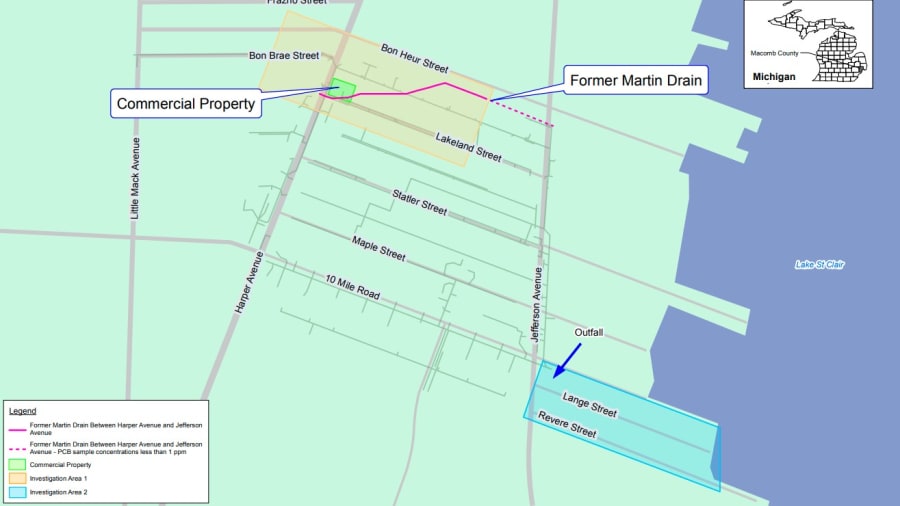ST. CLAIR SHORES, Mich. – The EPA has proposed a plan to clean up pipes and vaults at the 10 Mile Drain Superfund site in St. Clair Shores.
The 10 Mile Drain site includes an underground storm sewer utility that is contaminated with polychlorinated biphenyls (PCBs). The contamination is believed to come from a historical PCB release from a commercial property on the corner of Bon Brae Street and Harper Avenue.
The contaminants are believed to have worked their way through properties in the area and into the 10 Mile Drain storm sewer system. The storm sewer system is 15 feet below ground and discharges into the Lange and Revere Street canals, which are connected to Lake Saint Clair.
The 10 Mile Drain site is one of many across the U.S. to receive funding from the Bipartisan Infrastructure Law.
The EPA will host a public meeting on June 22 to answer questions and accept public comments on the proposed plan. Under the plan, crews would excavate six manhole vaults (two on Harper Avenue and four on Bon Brae Street), and 2,110 feet of pipe along with contaminated bedding and backfill.
The EPA would backfill those areas, install new pipe and manhole vaults, and dispose of the excavated material at a landfill. The EPA has also proposed alternatives to the plan.
- Date: June 22
- Open house: 5 p.m. - 6 p.m.
- Public meeting: 6:30 p.m.
- Location: St. Clair Shores City Council Chambers at 27600 Jefferson Ave., St. Clair Shores, Michigan.
More information about the 10 Mile drain superfund site is available online.

What are PCBs?
PCBs are a group of man-made organic chemicals consisting of carbon, hydrogen and chlorine atoms. They do not have a taste or smell. Their consistency can range from an oil to a waxy solid.
PCBs were commercially manufactured from 1929 until production was banned in 1979 by the Toxic Substances Control Act (TSCA). PCBs do not readily break down once in the environment. They can remain for long periods cycling between air, water and soil.
PCBs can accumulate in the parts of plants and food crops that are above ground. They can also be taken into the bodies of small organisms and fish. People who eat fish may be exposed to PCBs that have accumulated in the fish.
PCBs have been shown to cause cancer in animals and have other negative effects including effects on the immune system, reproductive system, nervous system, endocrine system and other health effects. Studies in humans show potential effects.
The EPA has more information online about PCBs.
How to submit a comment to the EPA
The EPA’s 30-day comment period on the plan ends on July 11.
People can submit a comment using the following methods:
- An open house will be held at St. Clair Shores City Council Chambers from 5 p.m. until 6 p.m. and a short presentation will be given at 6:30 p.m.
- Letters can be sent to Caitlin McIntyre, U.S. EPA Region 5, 77 W. Jackson Blvd., RE-19J Chicago, IL 60604-3590.
- Emails can be sent to mcintyre.caitlin@epa.gov



